
The Solar-Terrestrial Centre of Excellence (STCE) is a collaborative network of the Belgian Institute for Space Aeronomy, the Royal Observatory of Belgium and the Royal Meteorological Institute of Belgium.
 |
Published by the STCE - this issue : 10 Nov 2012. The Solar-Terrestrial Centre of Excellence (STCE) is a collaborative network of the Belgian Institute for Space Aeronomy, the Royal Observatory of Belgium and the Royal Meteorological Institute of Belgium. |
| Archive of the newsletters | Subscribe to this newsletter by mail |
Once again, last week's activity was not particularly exciting: Just a few small single sunspots, that was it! Also, the SIDC (http://www.sidc.be/index.php) announced that the provisional sunspot number for October was 53.3. That is the lowest since February this year. What a difference with the sunspot activity one year ago: Several groups dotted the solar surface during that November month, and also the biggest sunspot group so far this solar cycle (NOAA 1339) made its appearance. Obviously, one wonders if SC24-maximum has already passed.
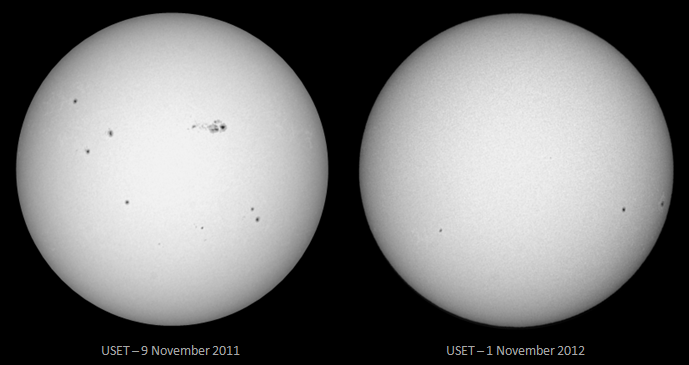
Though the smoothed International Sunspot Number (ISN) shows a maximum late 2011, chances are very low that this is the true maximum of SC24. There are several reasons to come to this conclusion. For example, a maximum late 2011 would mean that the time of rise (i.e. the time needed for a solar cycle to rise from its minimum to its maximum) would only be about 3 years. Such short rise times are usually reserved for very active and short cycles such as SC22 which only needed 37 months to reach its maximum sunspot number of about 160 in October 1989. In contrast, lower amplitude cycles like SC20 in 1969 and SC23 in 2000 needed already more than 4 years to reach their resp. maximum.
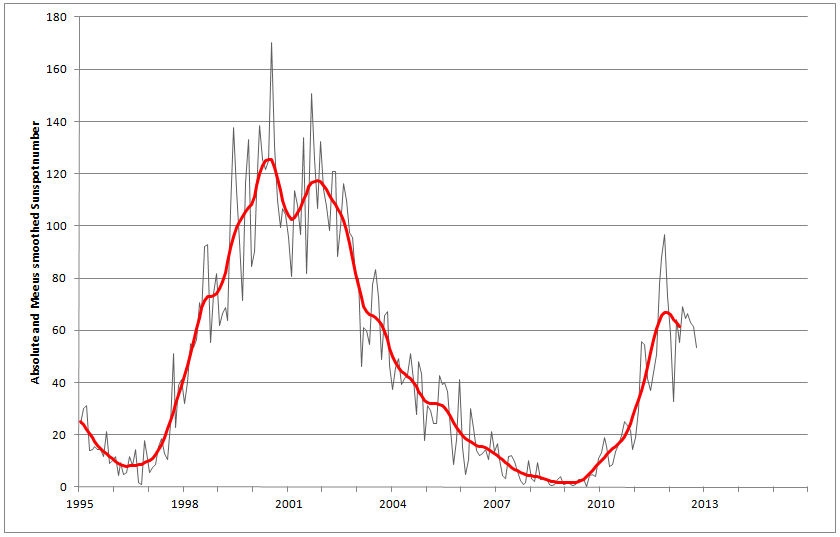
One can also see that last year's "maximum" was mainly due to activity on the northern solar hemisphere, which produced most of the big groups and strong flares. Since then, northern activity has subsided somewhat, while that on the southern hemisphere has gradually been increasing. It is reasonable to expect that when the southern sunspot maximum peaks, a new and higher sunspot maximum will occur, and that this might be the true SC24-maximum.
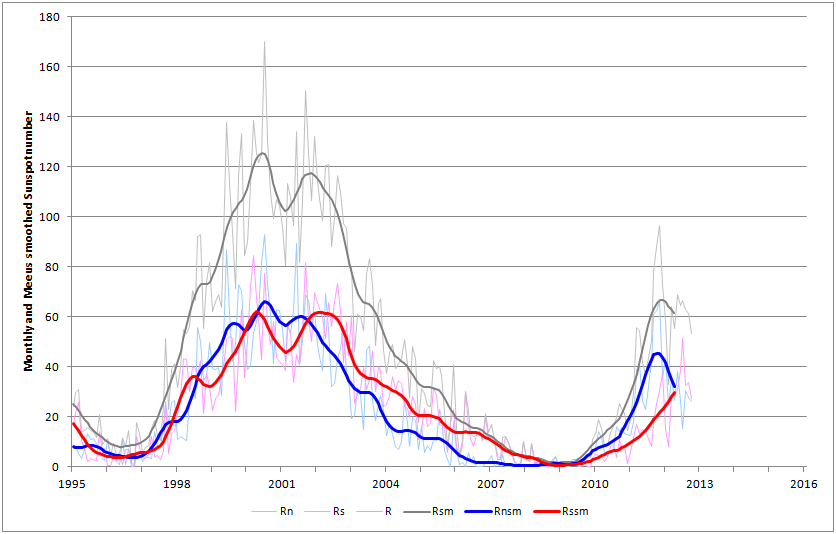
Low amplitude sunspot cycles are also known for a broad maximum with several ups-and-downs. Graph underneath compares the smoothed monthly sunspot number of the ongoing solar cycle with that of SC16. Clearly, one can see that a solar cycle can have multiple maxima, and that the first sunspot peak does not necessarily have to be the highest.
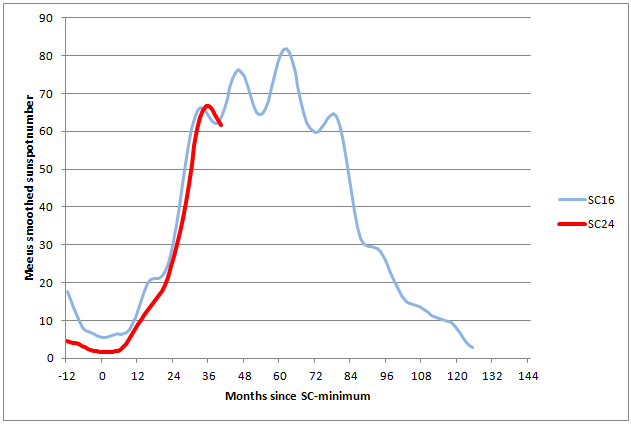
The average latitude at which the sunspot groups appear, is currently also very normal indicating that the true maximum is still to come. The groups on the northern hemisphere appear on the average a few degrees closer to the solar equator than on the southern, consistent with the higher activity that took place on the northern hemisphere late 2011.
All the above arguments are of course only indirect indications for a maximum that has not happened yet. Moreover, solar observers are well aware that the Sun isn't shy of pulling a new trick out of her sleeve. Nonetheless, a SC24-maximum that is yet to come (2013 - see SIDC-prediction charts at http://www.sidc.oma.be/sunspot-index-graphics/sidc_graphics.php ) is at the moment a lot more likely than the claim that the maximum took already place (late 2011).
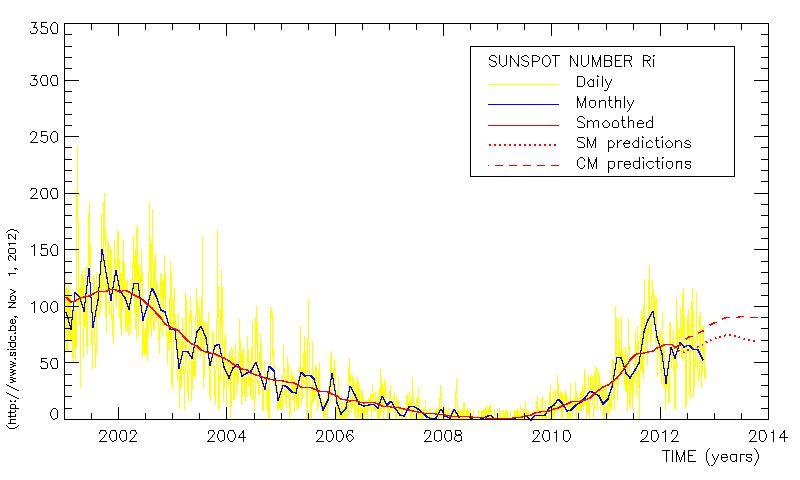
Solar activity was low with a C1.7 flare being the largest flare of the period (on Oct 28, source NOAA AR 1597 behind the west limb). A weak eruption and CME was observed late Oct 27 in STEREO data, which was probably the source of the magnetic cloud that arrived at Earth on late October 31. The eruption was discussed in the previous weekly bulletin.
Geomagnetic activity was very quiet (Kp smaller than 2) in the beginning of the period. A magnetic cloud arrived late October 31. The cloud is possibly linked with the CME eruption of Oct 27. As a consequence of the arrival, the interplanetary magnetic field was pushed southward to -10nT for many hours. As a result, geomagnetic activity was enhanced up till active geomagnetic conditions (Kp =4). From November 2 onwards, we returned to quiet geomagnetic conditions.
Start : 2013-01-14 - End : 2013-01-17
The Atacama Large Millimeter/submillimeter Array (ALMA), an
international partnership of Europe, North America and East Asia in
cooperation with the Republic of Chile, is the largest astronomical
project in existence.
The workshop aims to bring together the ALMA-minded solar
community to discuss solar observational issues with ALMA, solar
science and planned observations with ALMA, and the planning of
solar ALMA observations.
Th workshop is hosted by Astronomy & Astrophysics Group,
and will take place in School of Physics and Astronomy, University
of Glasgow, Room 323, Kelvin Building.
Website:
http://www.astro.gla.ac.uk/~eduard/solarALMA/
Start : 2013-02-04 - End : 2013-02-08
Helioseismology provides tools for imaging structures and mass
flows below the solar surface, and is becoming an essential
technique for understanding the dynamics of solar activities and
developing physics-based forecasts of the solar cycle, emerging
active regions and energy release events. A better understanding is
needed to unravel the effects of the complex interactions of solar
oscillations with the turbulent magnetized plasma
on global and local helioseismology
diagnostics. These effects are particularly challenging in regions
of strong magnetic fields. Numerical simulations of solar MHD waves
and turbulent dynamics give important insights into the complicated
wave and turbulence physics, and provide synthetic data for
verification and validation of helioseismology methods and
results.
The goals of this workshop are to discuss and stimulate further
development of helioseismology methods, solar interior models, and
realistic numerical simulations. These goals are particularly
important for analysis of the continuous data flow from the Solar
Dynamics Observatory, development and verification of
helioseismology methods, and for theoretical interpretation of
observations and inversion results.
Website:
http://sun.stanford.edu/LWS2013/
Start : 2013-02-28 - End : 2013-02-28
On February 28th, 2013 the AFFECTS team organises an
international user workshop at the Royal Observatory of Belgium in
Brussels.
At the workshop there will be a demonstration of all AFFECTS
space weather
products:
* Near real time dimming and EIT
wave detection
* 3D CME
analysis tool
* Coronal analysis tool
* CME
& solar wind
arrival and impact forecast
tool
* Flare, CME
, geomagnetic, auroral, ionospheric
forecasts & alerts
* Forecast of perturbed TEC
* Solar activity and space weather
timelines viewer
To register, please send an e-mail incl. your full name,
institution, e-mail and (institutional) address to
.
Dörte Dannemann
Website:
http://www.affects-fp7.eu/news-events/user-ws/
Start : 2013-04-07 - End : 2013-04-12
The EGU General Assembly 2013 will bring together geoscientists
from all over the world into one meeting covering all disciplines
of the Earth, Planetary and Space Sciences. Especially for young
scientists, it is the aim of the EGU to provide a forum where they
can present their work and discuss their ideas with experts in all
fields of geosciences. The EGU is looking forward to cordially
welcoming you in Vienna.
Website:
http://www.egu2013.eu/home.html
Start : 2013-04-08 - End : 2013-04-12
The most recent solar minimum, solar cycle 23-24 minimum, was
unusually long (266 spotless days in 2008, the most since 1913),
and the magnetic field at the solar poles was approximately 40%
weaker than the last cycle; and unusually complex (the solar wind
was characterized by a warped
heliospheric current sheet, HCS, and fast-wind
streams at low latitudes: the
fast-wind
threads the ecliptic
more commonly in 2008 than 1996.)
This complexity resulted in many effects observed from Sun to
Earth, with many observations indicating unusual conditions on the
Sun, in the heliosphere
, and in the magnetosphere
, ionosphere
, and upper atmosphere of the
Earth.
This remarkable set of conditions provide the scientific
community with an exceptional opportunity to assess the nature and
structure of a very quiet Sun, and an upper atmosphere relatively
devoid of solar influences, helping to provide a better
understanding of the relative roles of solar activity and internal
variability in the dynamics of the Earth's upper atmosphere and
ionosphere
. Such an understanding requires a
multidisciplinary approach.
The main goal of the conference is to bring together the solar,
heliospheric, magnetospheric, upper atmosphere, and ionospheric
communities to debate and discuss interdisciplinary work and reach
a better understanding of the nature and structure of a very quiet
Sun, and of an upper atmosphere relatively devoid of solar
influences, and in doing so, to help clarify the role of solar
activity in the dynamics and variability of the Earth's upper
atmosphere and ionosphere
relative to the internal
variations.
Website:
http://chapman.agu.org/solarminimum/
Start : 2013-05-06 - End : 2013-05-10
In the last 50 years, helioseismology has made significant
contributions to the knowledge of the Sun's interior physics
and has led the way to asteroseismology. We have now reached an era
where more sophisticated questions are being asked to understand
the subtle properties of the Sun and other stars due to the
synoptic and high-resolution observations available from BISON,
GONG and space missions such as SOHO
, SDO, CoRot and Kepler.
On this occasion, a workshop on the theme of '50 years of the
seismology of the Sun and stars' is being organized to reflect the
progress that has been made as well as to focus on future goals. We
plan to bring together helio- and asteroseismologists, theorists
and observers in a journey that will take us from the interior of
the Sun and its magnetism towards the structure of distant stars
and activity cycles.
Website:
http://www.nso.edu/workshops/2013
Start : 2013-06-23 - End : 2013-06-29
The 2013 ILWS Science Workshop will take place June 23-29, 2013
in Irkutsk, Russia and will be hosted by the Institute of
Solar-Terrestrial Physics of the Russian Academy of Sciences
Website:
http://en.iszf.irk.ru/ILWS_2013
Start : 2013-07-16 - End : 2013-07-25
The Summer School Alpbach enjoys 36 years of tradition in
providing in-depth teaching on different topics of space science
& technology, featuring lectures and concentrated working
sessions on mission studies in self-organised working groups. 60
young highly qualified European science and engineering students
converge annually for stimulating 10 days of work in the Austrian
Alps. 4 teams compete to design a space mission judged by a jury of
experts. Students learn how to approach the design of a satellite
mission and explore new and startling ideas supported by experts.
The Summer School 2013 will focus on Space Weather
.
The purpose of the Summer School is to foster the practical
application of knowledge derived from lectures, to develop
organisational and team-work skills and to encourage creativity.
Teams will compete to design the best project, judged by an
independent jury. The teams themselves are responsible for the
selection of the subject of the project and for the team structure
and working methods.
Website:
http://www.summerschoolalpbach.at/
Start : 2013-09-09 - End : 2013-09-14
We gain information about the universe through analysis of the
spectra from celestial objects. However, while the intensity
spectrum represents a scalar quantity but electromagnetic radiation
occurs in the form of transverse waves, the polarized spectrum
provides us with a 4-vector, the Stokes vector. The increased
amount of information space opens new windows to the universe, in
particular for the exploration of magnetic fields. It is well
recognized that the magnetic field is a primary agent responsible
for structuring and the source of all variability on intermediate
time scales, which manifests itself in all forms of solar and
stellar activity.
It is therefore not surprising that every year there are many
scientific meetings organized with the objective of studying the
role of magnetic fields in cosmic objects. What is largely missing
in these meetings is however an in-depth investigation of the
fundamental aspects of how magnetic fields can be determined by the
means of spectro-polarimetry, our main gateway to cosmic magnetism.
The primary aim of our series of Workshops is to address these
fundamental aspects, with less emphasis on the morphological and
physical properties of cosmic magnetic fields.
Website: http://spw7.ynao.ac.cn/
Start : 2014-08-02 - End : 2014-08-10
The 40th COSPAR Scientific Assembly will be held in Moscow,
Russia from 2 - 10 August 2014. This Assembly is open to all bona
fide scientists.
Website:
http://www.cospar-assembly.org/
Talk in the session Eruptive processes in the solar atmosphere and their manifestations in the heliosphere
http://www.spaceweather.eu/en/repository/show?id=281
http://www.spaceweather.eu/en/repository/show?id=298
Poster for the Session 1: Solar Magnetism and the Solar Cycle
http://www.spaceweather.eu/en/repository/show?id=299
Poster for the Session 1: Solar Magnetism and the Solar Cycle
http://www.spaceweather.eu/en/repository/show?id=300
Poster for the Session 1: Solar Magnetism and the Solar Cycle
http://www.spaceweather.eu/en/repository/show?id=301
Poster for the Session 2: Processes of slow/steady energy release in the solar atmosphere
http://www.spaceweather.eu/en/repository/show?id=302
http://www.spaceweather.eu/en/repository/show?id=303
Poster for the Session 2: Processes of slow/steady energy release in the solar atmosphere
http://www.spaceweather.eu/en/repository/show?id=304
Poster for the Session 2: Processes of slow/steady energy release in the solar atmosphere
http://www.spaceweather.eu/en/repository/show?id=305
Poster for the Session 2: Processes of slow/steady energy release in the solar atmosphere
http://www.spaceweather.eu/en/repository/show?id=306
Poster for the Session 2: Processes of slow/steady energy release in the solar atmosphere
http://www.spaceweather.eu/en/repository/show?id=307
Poster for the Session 2: Processes of slow/steady energy release in the solar atmosphere
http://www.spaceweather.eu/en/repository/show?id=308
Poster for the Session 2: Processes of slow/steady energy release in the solar atmosphere
http://www.spaceweather.eu/en/repository/show?id=309
Poster for the Session 2: Processes of slow/steady energy release in the solar atmosphere
http://www.spaceweather.eu/en/repository/show?id=310
Poster for the Session 3: Eruptive processes in the solar atmosphere and their manifestations in the heliosphere
http://www.spaceweather.eu/en/repository/show?id=311
Poster for the Session 3: Eruptive processes in the solar atmosphere and their manifestations in the heliosphere
http://www.spaceweather.eu/en/repository/show?id=312
Poster for the Session 3: Eruptive processes in the solar atmosphere and their manifestations in the heliosphere
http://www.spaceweather.eu/en/repository/show?id=313
Poster for the Session 3: Eruptive processes in the solar atmosphere and their manifestations in the heliosphere
http://www.spaceweather.eu/en/repository/show?id=314
Poster for the Session 3: Eruptive processes in the solar atmosphere and their manifestations in the heliosphere
http://www.spaceweather.eu/en/repository/show?id=315
Poster for the Session 3: Eruptive processes in the solar atmosphere and their manifestations in the heliosphere
http://www.spaceweather.eu/en/repository/show?id=316
Poster for the Session 3: Eruptive processes in the solar atmosphere and their manifestations in the heliosphere
http://www.spaceweather.eu/en/repository/show?id=317
Poster for the Session 3: Eruptive processes in the solar atmosphere and their manifestations in the heliosphere
http://www.spaceweather.eu/en/repository/show?id=318
Poster for the Session 3: Eruptive processes in the solar atmosphere and their manifestations in the heliosphere
http://www.spaceweather.eu/en/repository/show?id=319
Poster for the Session 3: Eruptive processes in the solar atmosphere and their manifestations in the heliosphere
http://www.spaceweather.eu/en/repository/show?id=320
Poster for the Session 3: Eruptive processes in the solar atmosphere and their manifestations in the heliosphere
http://www.spaceweather.eu/en/repository/show?id=321
Poster for the Session 3: Eruptive processes in the solar atmosphere and their manifestations in the heliosphere
http://www.spaceweather.eu/en/repository/show?id=322
Poster for the Session 3: Eruptive processes in the solar atmosphere and their manifestations in the heliosphere
http://www.spaceweather.eu/en/repository/show?id=323
Poster for the Session 3: Eruptive processes in the solar atmosphere and their manifestations in the heliosphere
http://www.spaceweather.eu/en/repository/show?id=324
Poster for the Session 3: Eruptive processes in the solar atmosphere and their manifestations in the heliosphere
http://www.spaceweather.eu/en/repository/show?id=325
Poster for the Session 3: Eruptive processes in the solar atmosphere and their manifestations in the heliosphere
http://www.spaceweather.eu/en/repository/show?id=326
Poster for the Session 3: Eruptive processes in the solar atmosphere and their manifestations in the heliosphere
http://www.spaceweather.eu/en/repository/show?id=327
Poster for the Session 3: Eruptive processes in the solar atmosphere and their manifestations in the heliosphere
http://www.spaceweather.eu/en/repository/show?id=328
Poster for the Session 4: Data assimilation, visualization and analysis
http://www.spaceweather.eu/en/repository/show?id=329
Poster for the Session 4: Data assimilation, visualization and analysis
http://www.spaceweather.eu/en/repository/show?id=330
Poster for the Session 4: Data assimilation, visualization and analysis
http://www.spaceweather.eu/en/repository/show?id=331
Poster for the Session 4: Data assimilation, visualization and analysis
http://www.spaceweather.eu/en/repository/show?id=332
Poster for the Session 4: Data assimilation, visualization and analysis
http://www.spaceweather.eu/en/repository/show?id=333
Poster for the Session 4: Data assimilation, visualization and analysis
http://www.spaceweather.eu/en/repository/show?id=334
Poster for the Session 4: Data assimilation, visualization and analysis
http://www.spaceweather.eu/en/repository/show?id=335
A one-day session and workshop was held on the subject of Geomagnetically Induced Currents (GIC) in electrical power networks at the 8th European Space Weather Week, in Namur, Belgium, on 30th November 2011. We describe the questions that were posed at the workshop and summarise the outcomes of the discussions. Among the conclusions reached were the need for improved Sun to Earth numerical models and the need for continued national and international support for space weather monitoring missions and ground networks of instruments. It was also concluded that there was much scope for improved national and international responses to space weather warnings and the need for collaboration between scientists, industry and governments to achieve this.
1.
http://www.spaceweather.eu/en/repository/show?id=336
Talk in the session Solar Magnetism and the Solar Cycle
http://www.spaceweather.eu/en/repository/show?id=337